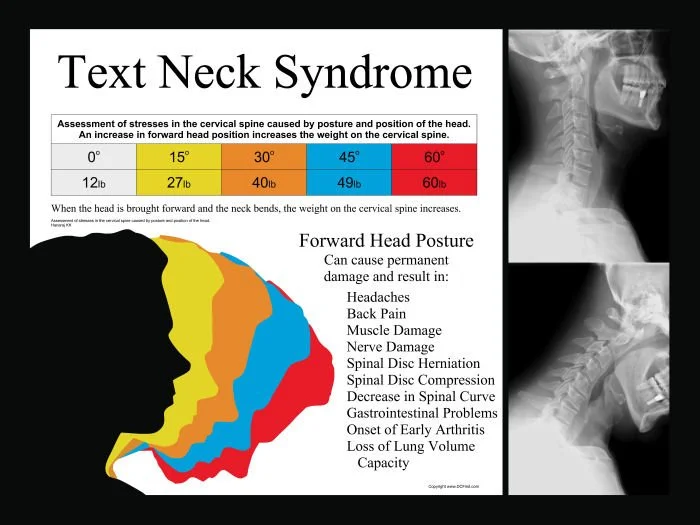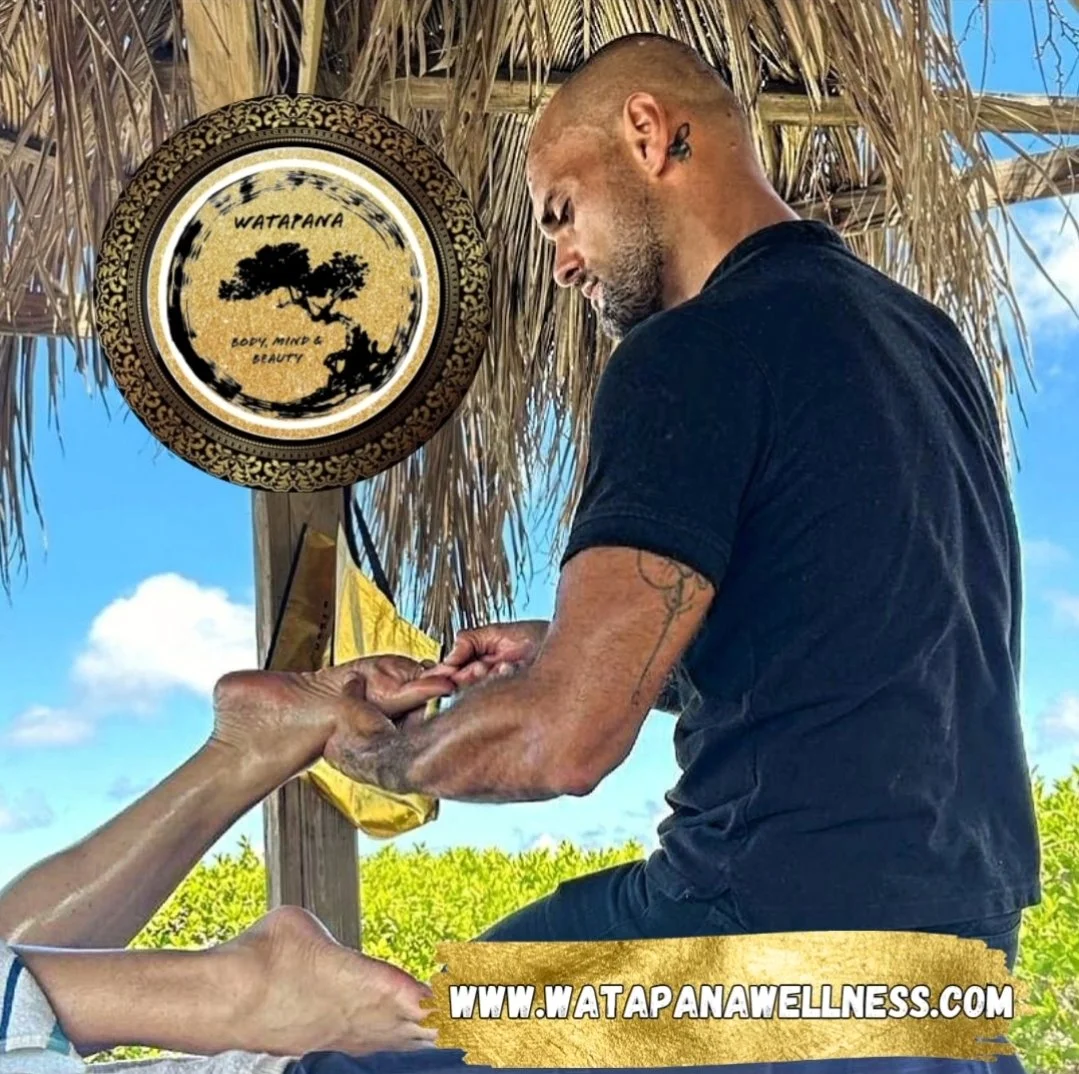Text Neck:
The Hidden Culprit Behind Physical Pains and the Rise of Forward Head Posture in Our Youth
A while back a 12 year old boy got brought in to my practice by his mother due to severe tensions and pains believed to be caused by his intense sports schedule and Mal posture caused by excessive usage of electronic devices. Something all to common, especially in our youth…
In today’s fast-paced digital world, where screens dominate our lives, many parents are becoming increasingly aware of the toll that excessive electronic device usage is taking on our children’s physical health.
One of the most alarming issues emerging from this trend is the incorrect forward head posture, commonly referred to as "text neck” or “Tech Neck”. This condition has become a worldwide epidemic, significantly affecting the physical well-being of our youth.
According to a 2017 study titled “Text Neck” published in the Spine Journal, spine surgeons observed a notable increase in the number of patients experiencing neck and upper back pain, with many of these patients being children. The research indicated that “text neck” exerts substantial pressure and tension on the spine as the head tilts forward and downward to view an electronic device. The average weight of the human head on the neck is approximately 4.5 to 5.4 kilograms when resting in a neutral position. Any forward head flexion increases the weight and pressure on the spine to varying extents. For every 15 degrees of forward neck flexion, an additional 4 to 5.4 kilograms of pressure is applied to the spine. At 60 degrees of forward flexion, this results in an extra 27 kilograms of pressure on the spine. Neck flexion typically ranges between 45 and 60 degrees while texting. A new diagnosis code called “text neck” has been created to categorize and address the damage caused by common daily activities, such as using electronic devices.
Understanding Forward Head Posture
Forward head posture occurs when the head is positioned too far forward in relation to the spine, often as a result of prolonged periods spent hunched over smartphones, tablets, and computers. This misalignment creates an imbalance in the body, leading to increased strain on the neck, shoulders, and upper back. Over time, this can result in a range of physical discomforts, including neck pain, sciatica, and chronic lower back issues.
Children and adolescents are particularly vulnerable to developing forward head posture due to their growing bodies and often sedentary lifestyles. As they engage with their devices for homework, socializing, and entertainment, they may unknowingly adopt poor posture habits that can have lasting impacts on their health.
The Long-Term Consequences of Poor Posture
It’s essential to understand that the habits we form in our youth can have significant repercussions as we age. Poor posture can lead to chronic pain, diminished mobility, and even issues with spinal alignment later in life. By addressing posture problems early on, we can help our children avoid serious health complications in adulthood.
Tips for Improving Posture
To combat the effects of forward head posture, parents and kids can implement a few simple strategies:
●1. Limit Screen Time: Encourage regular breaks from screens, aiming for 20 minutes of activity for every hour spent on devices.
Limiting Screen Time:
why?:
Excessive screen time can lead to poor posture and discomfort, especially as children are often engaged in sedentary activities. Encouraging breaks helps alleviate strain on the neck and back.
Examples:
- Set Timers: Use a timer to remind kids to take a five-minute break every 20 minutes during screen time. During the break, they could do simple activities like grabbing a snack, walking around, or stretching.
- Outdoor Activities: Encourage families to take a walk together or play outside for at least 20 minutes after an hour of screen time to promote a healthy lifestyle and foster family bonding.
●2. Practice Good Posture: Teach children to sit up straight, with their backs against the chair and feet flat on the ground. When using devices, the screen should be at eye level to prevent leaning forward.
Practicing Good Posture
Why?
Teaching children about proper posture is crucial for their comfort, health, and well-being. When they learn to sit and position themselves correctly, they can reduce the risk of body aches.
HOw:
- Demonstrate Sitting Techniques: Show your child how to sit with their back flat against the chair and feet flat on the floor. Use a book or a soft toy to help them visualize this posture.
- Screen Height Check: Encourage kids to use stands for tablets or laptops so that the screen is at eye level. You could also create a fun checklist for kids to ensure their workspace is set up ergonomically.
●3. Engage in Regular Exercise: Activities like swimming, yoga, and pilates can strengthen core muscles and improve overall posture.
Engage in Regular Exercise
Why?
Regular physical activity strengthens the core muscles, which support the spine, improving posture and reducing strain.
How:
- Family Classes: Find local classes for swimming, yoga, or pilates and attend together as a family. This not only promotes fitness but also sets a lasting example for kids about valuing health.
- Home Workouts: Set up a weekly routine where you do a fun workout session at home, like following a YouTube video for families. Incorporate activities that focus on strengthening core muscles like planks or bridging.
●4. Stretch Regularly: Incorporate simple stretching exercises into daily routines to relieve tension in the neck and shoulders.
Stretching Regularly
Why?
Regular stretching helps relieve muscle tension and improves flexibility, making it easier to maintain a good posture throughout the day.
How:
- Daily Stretch Routine: Create a short daily stretch routine that the family performs together in the morning or before bedtime. Include stretches for the neck, shoulders, and back.
- Stretch Breaks During Homework: Encourage kids to take gentle stretch breaks while doing homework. For instance, every 30 minutes, they can stand up, reach for the ceiling, and gently tilt side to side.
●5. Use Ergonomic Furniture: Invest in chairs and desks that promote good posture, especially for homework and study areas.
USing Ergonomic Furniture
why?
Investing in ergonomic furniture is vital for promoting good posture, particularly during study and homework sessions. The right furniture can significantly enhance comfort and support.
How:
- Chair Selection: When shopping for a new chair, look for one with good lumbar support and adjustable height. Let kids try out different chairs in-store to find one they feel comfortable in.
- DIY Solutions: If ergonomic furniture isn't accessible, consider DIY hacks to improve existing furniture. For instance, elevating the laptop using books can help create a better screen height while sitting.
By integrating these practices into daily life, both parents and kids can promote a culture of awareness regarding posture and its long-term benefits for comfort and health.
How Watapana Wellness Can Help
At Watapana Wellness, we recognize the importance of addressing malposture early to prevent long-term complications. Our team specializes in identifying the root causes of physical ailments and developing customized treatment plans tailored to each individual's needs.
Through regular physical therapy sessions and targeted stretching programs, we help alleviate the physical pains associated with forward head posture. Our expert therapists provide interventions designed to restore proper spinal alignment, ultimately leading to significant and sustainable improvements in overall health.
By prioritizing posture and seeking professional guidance at a young age, we can empower our children to lead healthier lives and significantly reduce the risk of chronic pain conditions in the future. As we navigate this digital age, let’s ensure that we equip our kids with the tools they need to maintain a balanced and healthy alignment, thus setting them up for a healthier and more active ànd comfortable adulthood.







